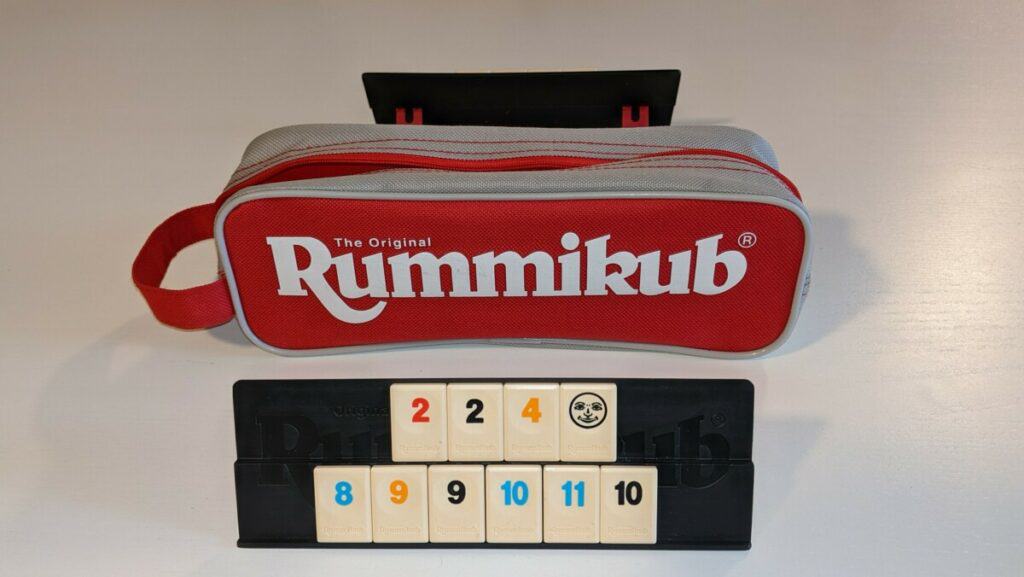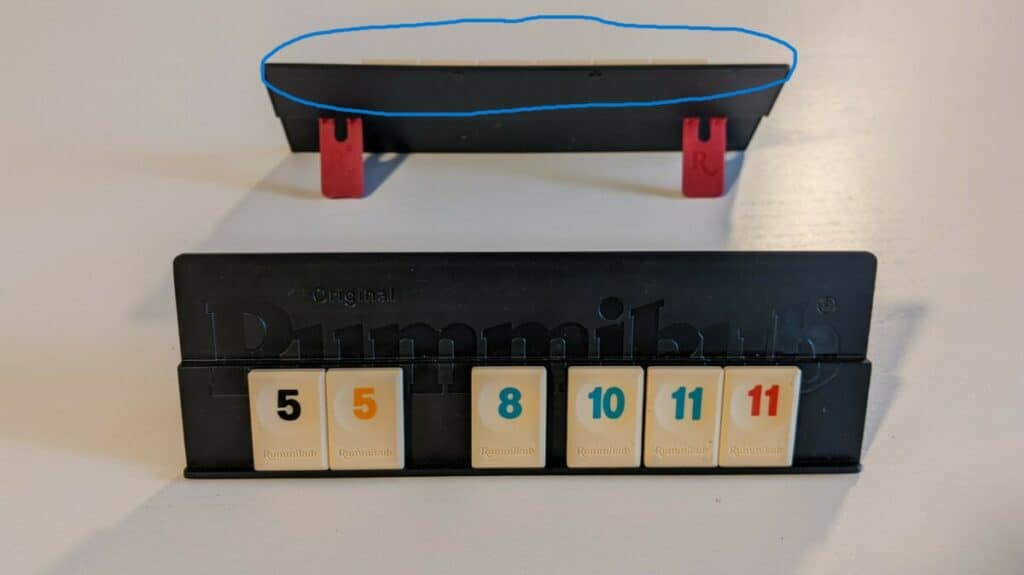
Rummikub combines a fun mixture of skill and luck, making it one of my favorite games to play with my family. I’ve been playing it off and on for most of my life and I’ve learned quite a few tricks and strategies to improve my game over time. When I recently began playing Rummikub more frequently with my family I wanted to dive deep into the strategy of the game to come out on top more often. These Rummikub strategies are simple but powerful tools to increase your winning chances.
In general, the best Rummikub strategies are to prioritize high-value tiles, hold some tiles to play in reserve, limit your opponents’ options, and use wild cards effectively. Specific strategies become more or less important depending on the phase of the game and the current board state.
Some of the detailed strategies below are not completely intuitive and can take a little bit of practice to fully understand. I’ll dive deep into how and why to apply these strategies in your own Rummikub games so you can implement them more quickly and effectively.
Play 1’s and 13’s whenever possible
One of the most powerful strategies in Rummikub is prioritizing playing tiles at the extreme ends of the number spectrum. This means that you should play any “1’s” and “13’s” whenever possible and, to a lesser extent, your “2’s” and “12’s”.
The reason for this is simple math – there are fewer possible numbers with which you can meld your 1’s and 13’s because they are at the extreme ends of the game’s number spectrum.

Let’s look at a “1” tile specifically. Since each tile must be played in a set of at least 3 tiles, that means there are 4 possible sets of 3 tiles in which a “1” of a specific color can be played. You can play it with the “2” and “3” of the same color, and with 3 combinations of differently colored “1’s”. The same is true for 13’s.
Tiles in the middle of the spectrum (3 through 11) have a total of 6 possible sets of 3 in which they can be played, making them much more flexible and easy to play from your rack. “2’s” and “12’s” fall in the middle, with only 5 possible combinations.
This simple fact means that “1’s” and “13’s” are, statistically, much more difficult to play than the rest of the numbers. If you have the opportunity to play them you should almost always take it because if you miss that chance it will likely be very difficult to play it in the future.
Hold some playable tiles in reserve
Keeping some tiles to play in subsequent turns is one of the most basic (and important) strategies in Rummikub. Since the goal of the game is to get rid of all of your tiles it is generally best to avoid adding more tiles to your hand. In Rummikub, you only draw a tile if you don’t play anything from your hand on your turn so it makes sense to ensure you have tiles in your rack that you can play in subsequent turns. Many players strive to have at least 3 moves worth of playable tiles held in reserve, but this is not always possible.
When deciding which tiles to keep in reserve it is usually best to hold sets of 3 or more in your rack, opting instead to play single tiles on melds already on the board. Holding sets is more powerful because they can’t be disrupted by other players, whereas you might miss an opportunity to play one-off tiles if the board is disrupted by your opponents.
You should also be wary of holding too many tiles late in the game since it becomes more likely that your opponents will go out and you’ll be stuck with a lot of points.
Prioritize playing duplicate tiles
Nothing is more frustrating in Rummikub than getting a bunch of duplicate tiles in your hand, by which I mean tiles of the exact same number and color. These tiles are less flexible and more difficult to get rid of than other tiles because there is usually only one opportunity on the board to get rid of a specific tile.
TIP: There are a ton of different versions of Rummikub for sale, but we love our Official Rummikub Travel Set (link to Amazon) because it packs down small and we can easily take it anywhere with us. Plus, the bag makes drawing tiles easy!
If you see an opportunity to play a duplicate tile you should almost always take it, even if it means playing fewer tiles from your hand overall on that turn.
Store your tiles on the bottom row

Keeping some or most of your tiles on the bottom row of your rack is a small way to put your opponents at a disadvantage. The top edges of any tiles on the top row of your rack can be seen by other players, making it easier for them to gauge how many tiles you have left. By keeping your tiles on the bottom row you’ll make it more difficult for your opponents to adjust their play. It’s a small advantage, but I’ll take anything I can get!
This tip isn’t viable in online play where the interface shows the number of tiles each player has remaining next to their username.
Hold your Wild Cards early in the game
Wild cards are the most powerful tool in the game because of the flexibility they give you. However, if you play your wilds early in the game you give that same flexibility to all of your opponents because they can then also make use of them.
It is best to hold your wild cards until later in the game. This is especially true if you are lucky enough to have drawn both wilds, or if you have one wild and the other has been played early. The chances that any of your opponents will be able to go out before you do are very slim, and it’s worth waiting to play your wild(s) until you can use your it to go out yourself.
If you have one wild card in your rack and you still don’t know where the other one is (in the pool or in your opponents’ rack) then it’s still worth waiting until the late middle game to play your wild. This gives you more flexibility as you get fewer tiles in your rack.
Keep tabs on your opponents
While your opponents are playing, pay attention to the tiles and sets they play and how it affects the board. Always keep a running tab of available moves and how your opponents’ moves affect your future options.
Advanced players will be able to keep a running tally of how many tiles their opponents have in their racks and use this information to gauge how urgent it is to get rid of high value tiles in their hand.
A player’s facial expressions when they draw tiles can be very telling. If they look and sound continually frustrated as they draw tiles it’s an indication that they are drawing unhelpful tiles, meaning you don’t have to be very concerned about them going out anytime soon. Just don’t fall for a bluff!
Play high-value tiles in the middle game
Sometimes the best thing you can do in Rummikub is to make sure that if you lose a round, you don’t lose it big. This means getting rid of high-value tiles (10-13) before your opponents go out and the round is over.
Most players will tend to prioritize playing high-value tiles throughout the game. They are the easiest tiles to make initial melds with (since initial melds have to total at least 30 points) and players know that they don’t want to be stuck with lots of points at the end of the round.
You can use this to a slight advantage by playing lower value tiles early on and then geting rid of your high-value tiles by adding on to high-value sets from your opponents during in the middle game. Just make sure not to wait too long to start ditching these tiles.
Optimize your use of Wild Cards on the board
It is absolutely imperative that you make use of any wild cards on the board, if possible. You should always start your turn by checking to see if you can free up a wild card so that you can use it for your own purposes.
Many new players use wild cards to play as many tiles from their own hand as possible. While this is sometimes the best course of action, it is usually better to use them to get rid of ‘problem’ tiles like dupicates or high-value tiles late in the game.
You should also strive to make it difficult for your opponents to use any wild cards you play. It is better to leave them locked in the middle of a 3 number run than to place them at the end of a run or in a set of 3 because it makes it harder for other players to access it.
Play and create smaller melds

Keeping your melds short limits options for other players. It is much easier to find available moves on a board with long runs and sets of 4 than it is when there are only sets/runs of 3 to be built upon.
Many players like to combine runs and rearrange sets so that they are easier to visualize and work with. However, it can often be to your advantage to leave things separate and divided to make it more difficult for your opponents. Don’t do the work for them! If you see that combining and rearranging is possible, wait until it is to your direct benefit to do so rather than doing it just for simplification’s sake.
Don’t get caught holding a Wild Card
I suggested holding on to your wild cards earlier in this article, and that is absolutely a good idea. However, you have to read the table and be mindful of the stage of the game you are in. The worst thing that can happen is to get caught holding a wild card when one of your opponents goes out and the round ends.
Once most of the tiles have been played and it’s clear that the end of the round is approaching you would be wise to play your wild card even if it doesn’t lead directly to you winning the round. Sometimes it’s best to make sure that you ‘lose small’ than try to win every round. Remember Rummikub consists of several rounds, so live to fight another day.
Hold lower value sets or runs late in the game
If you have sets or runs of low numbers (1 through 3 or 4) it is often prudent to hold them in your rack to be used on a later turn. If you have the option of playing a one-off tile on another meld (especially if it’s a high-value tile) then you should do that and then end your turn.
Your low-value sets/runs can be played at any time and can’t be disrupted by the moves of other players. They are also relatively low-risk since if you lose the round with them still in your hand they aren’t worth very many points. This gives you a really nice amount of flexibility relative to the risk you run by holding them.
Don’t go over the time limit
Most casual games don’t actually involve the use of a timer, but according to the rules of Rummikub you only have 1 or 2 minutes (depending on which variant you’re playing) to complete your turn. If you don’t finish your turn with all tiles in a valid meld at the end of the time limit you must undo your moves and draw a tile.
If you’re playing with a strict time limit then it’s crucial that you have your moves mapped out in your head ahead of time. Paying attention to the board as your opponents play is imperative. I even like to rearrange my tiles in my rack (or lay them down in front of the rack) as I watch my opponents play so that I know which tiles I have calculated I’ll be able to play.
Accept that drawing tiles is sometimes beneficial
Even though the goal of Rummikub is to get rid of all your tiles, it is often useful (or even necessary) to draw more tiles. Even if I have available moves to make I often elect to draw a tile and wait to play my tiles on a later turn.
This is especially true if you have a complete set or run in your hand. You can play it at any time, but playing it early on will give your opponent more options as well. Keep drawing until you have more sets or you get too many high-value tiles or duplicates.
Another benefit to drawing tiles is that you increase your odds of drawing a wild. Wild cards are, more often than not, the deciding factor in who wins a round so it is smart to give yourself lots of chances at drawing them.
Bait opposing players into playing tiles you need
This strategy can be tricky but extremely useful. If you need a particular tile to play a long run of numbers then you can sometimes ‘bait’ your opponents into putting it into play on the board.
Let’s say you have the blue 7, 8, 10, and 11. All you need is the blue 9 and you’d be able to play that run from your hand. If you can create a set of 9’s on the board using the orange, red, and black 9’s (from your rack, the board, or a combination of both) then that sets up your opponent to play a blue 9 on the set if they have it in their rack. If and when they play it, then you can take it on your next turn to complete your run of blue numbers.

Thanks for reading! If I missed something or you have your own opinions, please drop a comment below.
What is thr benefit of along out first in hand? Seems to me like you would never want to assume…
Your strategy comments are excellent, well thought out and very helpful! Thank you
You would only get to draw and play a Sanctuary card on turn two of round one if the Region…
Rule question. If in phase one of round one I play a Region card with a Clue symbol at the…

Leave a Reply